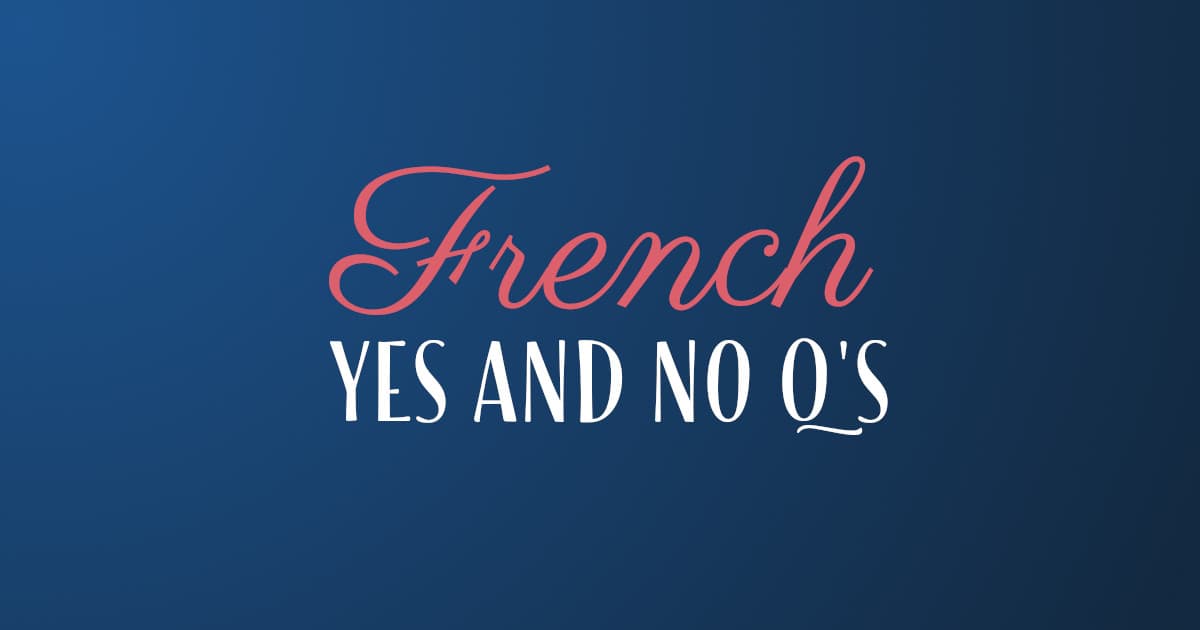Learn French: How To Ask Yes/No Questions In French
The simplest questions are questions that require only a Yes or No answer. In French, there are four main ways of asking such questions:
By inverting the order of the conjugated verb and the subject pronoun (simpler than it sounds).
By beginning an otherwise normal sentence with “est-ce que,” which translates literally as “is it that.” This is a way of asking for confirmation or negation of a straightforward statement.
By finishing a sentence with either “n'est-ce pas” or “c'est ça.” You can think of this as the mirror image construction of “est-ce que;” “est-ce que” opens the question and “n'est-ce pas” or “c'est ça” end it.
With a rising intonation at the end of a normal sentence.
Inversion is the most “correct” way to ask a question both in written and in spoken French. This is the form you should use in more formal settings (e.g. talking to a superior, a police officer or any civil servant, etc…). The rising-intonation or “c'est ça” questions are better suited to the more informal conversations with family and friends. Asking a question in French with “est-ce que” or “n'est-ce pas” is somewhere in the middle.
1. Inversion
1. Inversion is similar to the English form of asking a question “is he?”, “is it?”, “are they?”, “will we?”, etc. There are two differences you should note. The first is that inverting the verb and the pronoun requires that you add a hyphen between the two. The other is that when the third person singular of the verb ends in a vowel you must add –t– between the verb and the pronoun; this is so two vowel sounds won't clash.
Pronoun subject:
Est-il possible de passer? (Is it possible to get through?)
Êtes-vous certain? (Are you sure?)
Sommes-nous arrivé? (Have we arrived?)
A-t-il réussi? (Has he succeeded?)
Accueille-t-il ses amis? (Is he receiving his friends?)
When the subject in French is a noun (e.g. the ball, the captain, Roger) rather than a pronoun (e.g. I, you, we), the inversion uses an additional pronoun subject that matches the gender and number of the noun.
Noun subject:
Le train est-il à l'heure? (The train, is it on time?)
Le train: masculine, 3rd person singular è matching pronoun is il.
Les ouvriers font-ils la grève? (The workers, are they striking?)
Les ouvriers: masculine, 3rd person plural è matching pronoun is ils.
La poste est-elle ouverte? (The post office, is it open?)
La poste: feminine, 3rd person singular è matching pronoun is elle.
2. Est-ce que
2. Using Est-ce que is a straightforward process. Take a normal sentence and put est-ce que in front of it. This turns a declarative statement (e.g. Tu as faim / You are hungry) into an interrogative one (e.g. Est-ce que tu as faim? / Literally: Is it that you are hungry? Or more plainly: Are you hungry?)
Examples:
Est-ce qu'il fait beau? (Is the weather nice outside?)
Est-ce que nous irons voir le film? (Will we go see the movie?)
3. N'est-ce pas or C'est ça
3. N'est-ce pas and C'est ça can mean “right?” or “is that it?” They are also equivalent to the English constructions “is/are … isn't/aren't” and “do/does … don't/doesn't.”
Examples:
Il fait beau, n'est-ce pas? (It's nice outside, isn't it?)
Tu sais faire la cuisine, n'est-ce pas? (You know how to cook, don't you?)
Nous ne devons pas courir, c'est ça? (We mustn't run, is that it?)
Je ne te comprends pas, c'est ça? (I don't understand you, is that it?)
Tu veux des bisoux, c'est ça? (You want kisses, is that it?)
** You should note two things about these two expressions. N'est-ce pas is a negative which means that it should only be paired with a positive statement. By contrast, c'est ça while it's a positive, it can be paired with either a positive or a negative.
4. Intonation
4. Rising Intonation is a strictly verbal way of asking a question in French. This is because, on paper, there is no difference between a declarative statement and one that's been turned into a question through rising intonation. (e.g. Tu te portes bien. / You are doing well. vs. Tu te portes bien? / You are doing well?). Note that there is no reorganizing or adding of words. The only difference is in the higher pitch of your voice as you end your statement. Expressions of disbelief in American English can use a similar mechanism. Think back to your favorite Hollywood blockbuster and picture the sidekick asking, “You did what??????” Your voice should have risen noticeably.
Examples:
Il a couru? (You mean) He ran?
On a raté le train? (You mean) We missed the train?
Vous les avez battu? (You mean) You beat them?
The (You mean) in the examples above is not part of the translation.
It is there merely as a way to convey the proper amount of disbelief and help you achieve a rising intonation.

SUBSCRIBE: